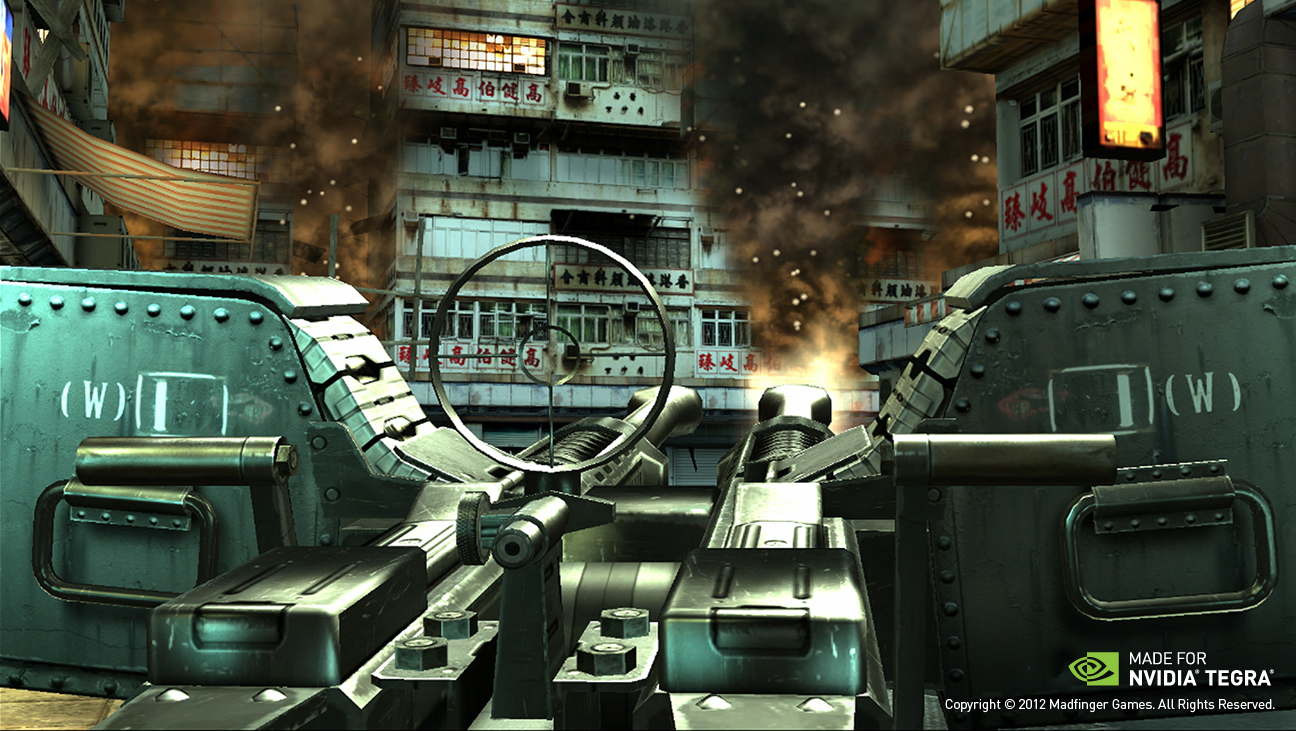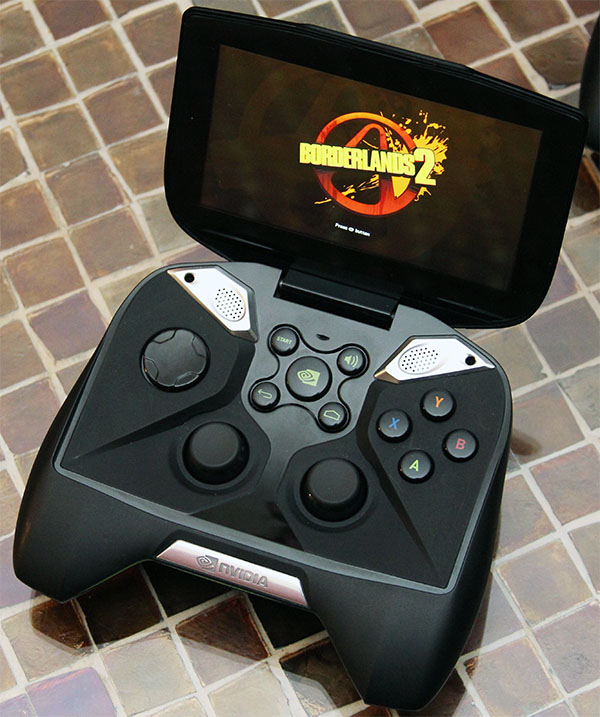Nvidia Shield: Hands-On With A Tegra 4-Based Handheld
Our first stop at this year's CES was Nvidia's suite in the Palms, where company representatives showed off pre-production versions of its Shield handheld. Chris Angelini weighs in with some of the specifics, plus his impressions of Nvidia's effort.
Nvidia Shield: Presenting The Turn
We were still in Southern California when Nvidia introduced its Project Shield. But that didn't stop Don and I from following the webcast and posting our initial thoughts online in CES 2013: Nvidia Announces Project Shield And Tegra 4. The next day, the Tom’s Hardware team landed in Las Vegas, ready for the show (more specifically, everyone else landed; I drove).
My first stop was Nvidia, where I got to go hands-on with a pre-production version of the Shield. The company was emphatic that what you saw during Jen-Hsun’s introduction was an early version of the hardware; it isn’t expected to ship until the second quarter of this year, and will be among the first devices with Tegra 4 inside.
Gaming On Android
I’ll preface this with what I told Nvidia: I don’t spend a lot of time gaming on mobile devices. I think I might have a free version of Angry Birds installed on my iPhone, and it’d take something really compelling to make me want to buy a game on one of my Windows 8 or Android tablets.
With that said, the build of Hawken the company had running on its Shield looked surprisingly detailed. I figured I could get pretty good at the game using the handheld’s joysticks. It’s a shame that the UDK-based title's free-to-play model is already being derided for goading you into buying upgrades with real-world currency just to stay competitive. We’ll have to see if Meteor’s model carries over from Windows into Android.
Nvidia is quick to point out a few other upcoming titles with planned optimizations for Tegra 4: Blood Sword: Sword of Ruin, Real Boxing, and Dead Trigger 2. My only beef with the optimizations developers are making (first mentioned in Nvidia's Tegra 3 Optimizations: THD Android Games, Tested), is that they’re restricted under Android via device detection. But when you play a cross-platform title under iOS or Windows, that detection doesn’t always happen. In some games, you see the same effects on SoCs from Apple, Qualcomm, and Intel.
Will the first wave of Tegra 4-optimized titles run smoothly on A6/A6X, Snapdragon S4, and Atom Z2760? Or will Tegra 4’s more powerful graphics subsystem enable games that can only be enjoyed at their highest settings on Nvidia’s Shield? More so now than on the prior generation of hardware, Shield stands to enjoy a notable advantage in Android-based games right out of the gate.
Get Tom's Hardware's best news and in-depth reviews, straight to your inbox.
The Wizard Behind The Curtain
Much of what Shield can do beyond gaming natively in Android is owed to Nvidia’s other technologies. For example, the device is able to access your library of PC games through Valve’s Steam platform and present them neatly on-screen. Actually firing them up and playing them, however, requires a desktop PC with at least a GeForce GTX 650 or a notebook with a GeForce GTX 660M.
Nvidia’s requirements also list a Core i5 or equivalent CPU (AMD processors included). Quick Sync does not play a role in this relationship. Rather, the GPU renders the game locally on the PC. Its fixed-function NVEnc logic turns the output into an H.264-encoded video, which is then sent to the Shield over a suitably-fast wireless network.
The company says an 802.11a/g/n router should be enough. That makes sense—you shouldn’t ever need 54 Mb/s of throughput for a compressed video stream. But peak performance isn’t the issue. I’m more interested in how high of a data rate the network needs to sustain, at minimum, to achieve smooth playback. Dips in the wireless valley matter most.
The Shield does its part with a dual-band 802.11n radio from Broadcom, two transmit antennas, and two receive antennas. If you’re able to match the handset up to a MIMO-equipped router, dual spacial streams should give you higher throughput at any given distance, improving the likelihood you’ll have a fluid experience.
At launch, Nvidia says it will support streaming PC games from your PC to the Shield. You will be able to connect an HDMI cable to your TV and mirror the output there. In the future, the company hopes to stream directly from your PC to the TV, using Shield as a controller. What won’t happen, it sounds like, is a wireless link between the PC and Shield, and a wireless link between the Shield and TV, which would introduce too much latency.
Current page: Nvidia Shield: Presenting The Turn
Next Page PC Gaming And The Shield's Secret Weapon-
mayankleoboy1 Naughty Naughty Chris!Reply
Hogging the better handheld for yourself, and giving the inferior one to Don ;) -
jase240 Streaming games to a tablet, its awesome! Now I wonder if it would be possible to stream on 4g?!?! That would be cool!Reply -
esrever Shield is nice but probably not worth the price in the end judging by how much nvidia is pushing it as a high end product.Reply -
lradunovic77 This is end of Windows because NVIDIA and soon Steam will clearly show to the world that you don't need Windows to do gaming, but actually Linux is really good platform for it.Reply -
wolley74 the question is, why would i want to stream a game from my PC, where i can use a mouse / keyboard / multiple monitors if i wish, compared to playing it on a tiny screen with limited buttons? why?Reply -
obsama1 lradunovic77This is end of Windows because NVIDIA and soon Steam will clearly show to the world that you don't need Windows to do gaming, but actually Linux is really good platform for it.Reply
Linux is great, but you have to remember two things:
1. Devs will have to port their games to Linux, which will take a long time.
2. I don't see how you're going to convince gamers to install Linux in place of Windows on their computers, and then download their entire game library again, due Linux/Windows incompatibilities. -
dark_knight33 lradunovic77This is end of Windows because NVIDIA and soon Steam will clearly show to the world that you don't need Windows to do gaming, but actually Linux is really good platform for it.Reply
3 words: Poor....driver....support...
Where's Linus giving Nvidia the finger when you need him? Afaik, you still need a windows based PC to enable streaming of steam titles.
That being said, I look forward to the day when MSFT looses it's death grip on those O/S license fees. -
dragonsqrrl It's an interesting concept, and it's impressive that Nvidia seems to have pulled off PC title streaming so effectively, but I feel like without the ability to stream remotely Shield will be little more than a niche product. I guess that's okay since Nvidia has openly stated that Shield's target audience is relatively small, but I can't help but feel that the experience could be so much more compelling with the ability to play your PC games from anywhere with a suitably fast internet connection, even if it's potentially at the expense of some image quality and latency. That would certainly get my attention.Reply


